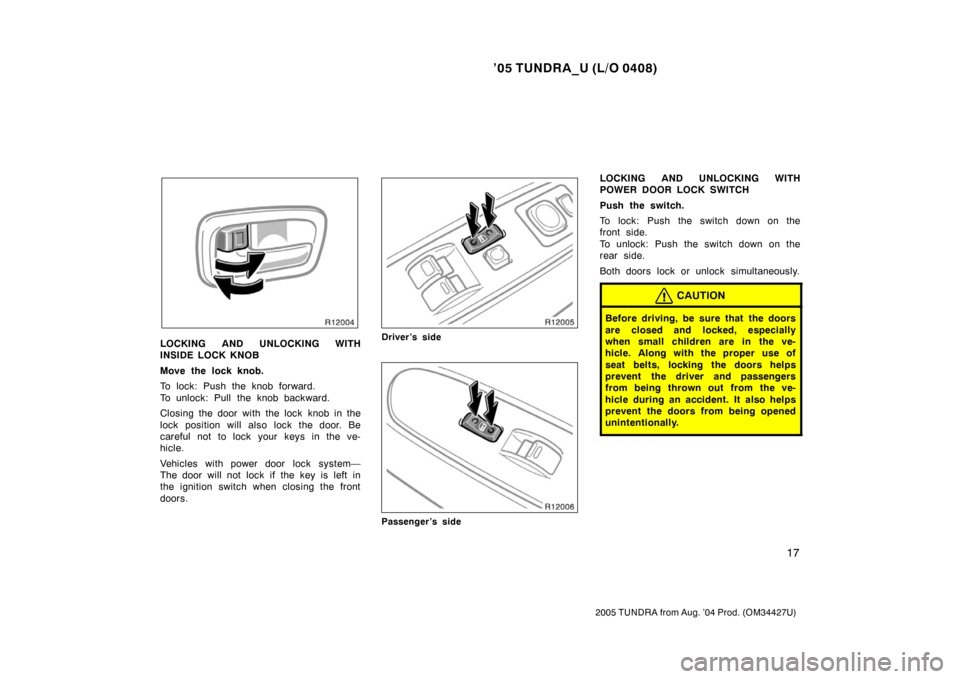Page 3 of 506

’05 TUNDRA_U (L/O 0408)
iii
2005 TUNDRA from Aug. ’04 Prod. (OM34427U)
Important information about your Toyota
Occupant restraint systems
Toyota encourages you and your family to take the time to
read Section 1 −3 of this Owner’s Manual carefully. In
terms of helping you understand how you can receive the
maximum benefit of the occupant restraint systems this
vehicle provides, Section 1 −3 of this Owner ’s Manual is
the most important Section for you and your family to
read.
Section 1 −3 describes the function and operation concern-
ing seats, seat belts, SRS airbags and child restraint sys-
tems of this vehicle and some potential hazards you
should be aware of. These systems work together along
with the overall structure of this vehicle in order to provide
occupant restraint in the event of a crash. The effect of
each system is enhanced when it is used properly and
together with other systems. No single occupant restraint
system can, by itself, provide you or your family with the
equal level of restraint which these systems can provide
when used together. That is why it is important for you and
your family to understand the purpose and proper use of
each of these systems and how they relate to each other.
The purpose of all occupant restraint systems is to help
reduce the possibility of death or serious injury in the
event of a collision. None of these systems, either individ-
ually or together, can ensure that there is no injury in the
event of collision. However, the more you know about
these systems and how to use them properly, the greater
your chances become of surviving an accident without
death or serious injury.
Seat belts provide the primary restraint to all occupants of
the vehicle, and every occupant of the vehicle should wear
seat belts properly at all times. Children should always be
secured in child restraint systems that are appropriate for
their age and size. SRS (Supplemental Restraint System)
airbags are, as their names imply, designed to work with,
and be supplemental to, seat belts and are not substitutes
for them. SRS airbags can be very effective in reducing
the risk of head and chest injuries by preventing contact of
the head and chest with interior portions of the vehicle.
Page 4 of 506

’05 TUNDRA_U (L/O 0408)
iv
2005 TUNDRA from Aug. ’04 Prod. (OM34427U)
In order to be effective, the SRS airbags must deploy with
tremendous speed. The rapid deployment of the SRS air-
bags makes the SRS airbags themselves potential sources
of serious injury if an occupant is too close to an airbag,
or if an object or some part of his or her body has been
placed between the occupant and the airbag at the time of
deployment. This is just one example of how the instruc-
tions in Section 1 −3 of this Owner ’s Manual will help en-
sure proper use of the occupant restraint systems, and
increase the safety they can provide to you and your fami-
ly in the event of an accident.
Toyota recommends you to read the provisions in Section
1 −3 carefully and refer to them as needed during your time
of ownership of this vehicle.Event data recorder
Your vehicle has computers that monitor and control cer-
tain aspects of your vehicle. These computers assist in
driving and maintaining optimal vehicle performance. Be-
sides storing data useful for troubleshooting, there is a
system to record data in a crash or a near car crash
event. This is called an Event Data Recorder (EDR).
The SRS airbag sensor assembly contains the EDR. In a
crash or a near car crash event, this device records some
or all of the following information:
� Engine speed
� Whether the brake pedal was applied or not
� Vehicle speed
� To what extent the accelerator pedal was depressed
� Position of the transmission selector lever
� Whether the driver and front passenger wore the seat
belts or not
� Driver’s seat position
� Front passenger ’s occupant classification
Page 8 of 506

’05 TUNDRA_U (L/O 0408)
viii
2005 TUNDRA from Aug. ’04 Prod. (OM34427U)
Installation of a mobile
two− way radio system
As the installation of a mobile two −way radio system in
your vehicle could affect electronic systems such as fol-
lows, be sure to check with your Toyota dealer for precau-
tionary measures or special instructions regarding installa-
tion.
� Multiport fuel injection system/sequential multiport fuel
injection system
� Electronic throttle control system
� SRS airbag system
� Seat belt pretensioner system
� Anti −lock brake system
� Traction control system
� “AUTO LSD” system
� Vehicle stability control system
� Cruise control system
� Tire pressure warning system
Tires and loading on your
To y o t a
Underinflated or overinflated tire pressure and the
excess load may result in the deterioration of
steering ability and braking ability, leading to an
accident. Check the tire inflation pressure periodi-
cally and be sure to keep the load limits given in
this Owner ’s Manual. For details about tire inflation
pressure and load limits, see “Checking tire infla-
tion pressure” in Section 7−2 and “Vehicle load
limits” in Section 2.
Page 9 of 506

’05 TUNDRA_U (L/O 0408)
ix
2005 TUNDRA from Aug. ’04 Prod. (OM34427U)
Scrapping of your Toyota
The SRS airbag and seat belt pretensioner devices in your
Toyota contain explosive chemicals. If the vehicle is
scrapped with the airbags and pretensioners left as they
are, this may cause an accident such as fire. Be sure to
have the systems of the SRS airbag and seat belt preten-
sioner removed and disposed of by a qualified service
shop or by your Toyota dealer before you dispose of your
vehicle.
On−pavement and off −road
driving tips
This vehicle will handle and maneuver differently from an
ordinary passenger car because it is designed for off −road
use also. It has a significantly higher rollover rate than
other types of vehicles. In addition, this vehicle has a
higher ground clearance and center of gravity than that of
an ordinary passenger car. This vehicle design feature
causes this type of vehicle to be more likely to rollover.
Failure to operate this vehicle correctly may result in loss
of control, accidents or vehicle rollover causing death or
serious injury. Be sure to read “Off −road vehicle precau-
tions” in Section 2 and “Off −road driving precautions” in
Section 3.
Page 16 of 506
’05 TUNDRA_U (L/O 0408)
5
2005 TUNDRA from Aug. ’04 Prod. (OM34427U)
1. Outside rear view mirror heater switch
2. Power back window switch
3. Headlight, turn signal and front fog
light switches
4. Ignition switch
5. Wiper and washer switches
6. Automatic transmission shift position “L” switch (“SHIFT L” switch)
7. Emergency flasher switch
8. Audio system or navigation system including audio system
(For the navigation system, see the
separate “Navigation System Owner ’s
Manual”)
9. Air conditioning controls
10. Front passenger ’s occupant classification indicator light/front
passenger ’s seat belt reminder
light/passenger airbag on −off indicator
light
11. Cargo lamp switch
12. Clock
13. “4LO” switch (transfer mode selector switch)
14. Cup holder
Page 20 of 506
’05 TUNDRA_U (L/O 0408)
9
2005 TUNDRA from Aug. ’04 Prod. (OM34427U)
1. Power back window switch
2. Power rear view mirror control switches
3. Roll sensing of curtain shield airbags
off switch (“RSCA OFF” switch)
4. Instrument panel light control knob
5. Headlight, turn signal and front fog light switches
6. Wiper and washer switches
7. Automatic transmission selector lever
8. Automatic transmission shift position “L” switch (“SHIFT L” switch)
9. Audio system or navigation system including audio system
(For the navigation system, see the
separate “Navigation System Owner ’s
Manual”)
10. Air conditioning controls 11. Front passenger ’s occupant classification indicator light/front
passenger ’s seat belt reminder light
12. Cargo lamp switch
13. Back window and outside rear view mirror defogger switch
14. Clock
15. Cup holder
16. Power outlets
17. Ashtray
Page 24 of 506
’05 TUNDRA_U (L/O 0408)
13
2005 TUNDRA from Aug. ’04 Prod. (OM34427U)
Driver ’s seat belt reminder light∗
1
Low engine oil pressure warning light∗1
Low fuel level warning light∗1
Brake system warning light∗1
Discharge warning light∗1
Malfunction indicator lamp∗1
Anti −lock brake system warning light∗
1or
Front passenger ’s seat belt reminder light∗1
�Vehicle stability control system warning
light∗1
�Traction control system warning light∗1
�“AUTO LSD” system warning light∗1
SRS warning light∗1
Automatic transmission fluid temperature
warning light∗1 (four −wheel drive models)
Unengaged “Park” warning light
∗
1
Low windshield washer fluid level warning
light∗1
Open door warning light∗1
Low tire pressure warning light∗1
Engine oil replacement reminder light∗1
(for vehicles sold in U.S.A.)
Indicator symbols on the instrument panel
Page 28 of 506

’05 TUNDRA_U (L/O 0408)
17
2005 TUNDRA from Aug. ’04 Prod. (OM34427U)
LOCKING AND UNLOCKING WITH
INSIDE LOCK KNOB
Move the lock knob.
To lock: Push the knob forward.
To unlock: Pull the knob backward.
Closing the door with the lock knob in the
lock position will also lock the door. Be
careful not to lock your keys in the ve-
hicle.
Vehicles with power door lock system—
The door will not lock if the key is left in
the ignition switch when closing the front
doors.Driver’s side
Passenger’s side
LOCKING AND UNLOCKING WITH
POWER DOOR LOCK SWITCH
Push the switch.
To lock: Push the switch down on the
front side.
To unlock: Push the switch down on the
rear side.
Both doors lock or unlock simultaneously.
CAUTION
Before driving, be sure that the doors
are closed and locked, especially
when small children are in the ve-
hicle. Along with the proper use of
seat belts, locking the doors helps
prevent the driver and passengers
from being thrown out from the ve-
hicle during an accident. It also helps
prevent the doors from being opened
unintentionally.